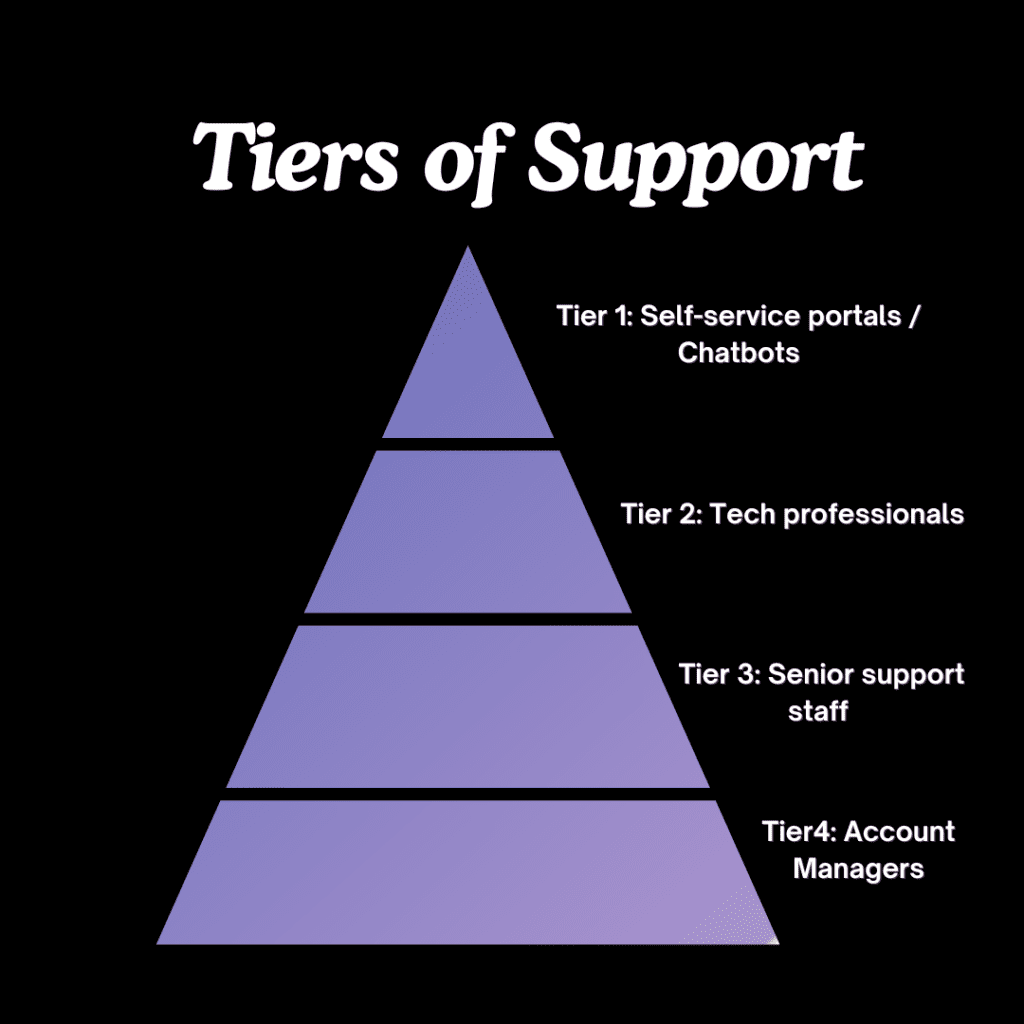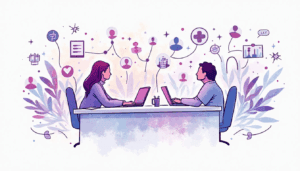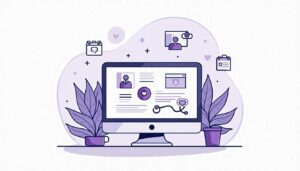Customer Service Tiers: Understanding the Different Levels of Support
02 Dec 2023 By: Michael Kansky
Updated
Tiers of Support is crucial for any product or service. It helps users get help with problems or guidance. Support varies in frameworks and level based on the issue’s complexity. This piece explores the various tiered support customer service model and their importance in providing effective help.
What are customer service tiers?
These tiers of support are different levels of help offered to users. Each tiered technical support level matches the problem’s complexity and the expertise needed to solve it. This system lets companies use resources wisely and ensures people get the right help for their needs.
A support tier sorts support staff by their skills and job roles. Each level deals with more complex user questions or problems. This setup helps manage support smoothly and makes sure users get the help they need.
For instance, in an IT service, the Tier 1 instructions have agents ready to tackle simple questions and offer basic fixes. They know a lot, or might use AI help, to quickly sort out ordinary problems. But if things get tricky or need expert knowledge, they’ll pass the user to a more advanced support level.
Tier 2 are made up of district leaders or engineers who really know the product inside out. They’re great at solving tough technical problems and can offer more advanced fixes. Sometimes, they even work with the developers to fix software bugs or create special solutions for intensive interventions.
The top support level is for real experts or senior engineers with deep knowledge in their field. They tackle the toughest problems, like system crashes or big software glitches. This level might need special education services from school districts or certificates to make sure users get the best help possible.
Why do organizations use tiered support?
Organizations use tiered support to ensure customers get help quickly and efficiently. Basic issues are resolved by lower-level teams, leaving experts to tackle more complex problems. This approach keeps support streamlined, reduces wait times, and ensures customers receive the right level of help when they need it most. It balances expertise and efficiency, making the overall experience smoother for everyone.
Importance of Support Tiers

Using different tiers of support levels is key to fixing user problems well. It lets companies use their Help Desk Support smartly, speed up responses, and make sure users get help from the right experts. This makes the customer issues experience better, keeps customers happy, and encourages them to stick around.
Support levels help companies give just the right help to each user. For example, using a robust Knowledge Base Management system can streamline responses by providing agents with easy access to solutions for common issues, helping resolve simple queries quickly.
Support levels also let companies focus on their best resources where they’re needed most. By having their top customer support agents tackle the big problems, they make sure urgent issues get fixed fast and well.
Support levels also help teams get smarter and better together. As support folks learn and grow, they can move up to tackle harder problems. This boosts not just the team’s skills but also the quality of help users get.
In short, tiered customer service models are super important for handling user help the right way. They sort support by how tricky or technical issues are, helping companies use their resources wisely, answer faster, and make sure everyone gets the help they really need.
Exploring the First Tier of Support

The first support level, also known as tier 1 agents, is where users first reach out for help. Here, the focus is on answering simple questions, fixing common problems, and giving basic advice to users.
When users run into issues or have questions, they usually contact the first level of support through calls, emails, or live chat. The reps at this level are key in making sure users get the help they need quickly and easily.
The main job of the first support level is to help users fast and right. They answer simple questions, fix easy problems, and walk users through basic fixes. Their aim is to quickly sort out user issues and make them happy with the solutions.
First level support representatives are like the company’s welcoming committee for users. Their job is to make users feel good by being kind, understanding, and patient and in over all, a positive customer experience. They need to listen well to what users are saying and explain solutions in a way that’s easy to understand.
Level 1 support doesn’t have to be kept inside the company; it can be outsourced. This gives businesses a chance to save money, use resources better, and access a wide range of experts with strong technical skills.
Role of First Tier Support
First level support does more than just fix problems. These reps also represent the company’s values and show how much it cares about customer happiness. They work hard to build trust and strong connections with users, making sure everyone feels supported and important during their interactions for quality service.
Besides fixing customer inquiries, first level support also keeps detailed notes and passes trickier issues up to higher support levels when needed. They log everything about user chats, like what the issue was, how they tried to solve it, and any extra details that might help later on.
Skills Required for First Tier Support
People in first level support need to be great at talking and solving problems. Being good at communication helps them figure out what users need, explain tech stuff simply, and give clear, step-by-step help for fixing issues.
Support representatives really need to know their stuff about the product or service they’re helping with. This know-how lets them spot normal problems fast and give the right solutions. They also keep up with new features and updates so they can help users with anything new that comes up.
Being able to juggle several tasks at once is key for support representatives. They need to sort through their work quickly and smartly, making sure no one is stuck waiting too long for help.
Staying cool when things get tough is super important for first level support. Users might be stressed or annoyed when they call for help, so the technical support team need to be calm and kind. They have to smooth over any rough spots and make sure users feel heard and helped.
In short, first level support is crucial for giving users the help they started with. Their knowledge, way of talking, and focus on making customers happy create a great experience. This helps form strong bonds between users and the company, and it builds better customer service.
Diving into the Second Tier of Support
Level 2 or the IT support level steps in when things get too complicated for the first level. Here, the professionals that have more technical knowledge work on the tougher issues that need a deeper understanding and special know-how.
Responsibilities of Second Tier Support
Level 2 support digs into the harder problems that the first level couldn’t fix. They look into system details, spot patterns, and use advanced methods to solve issues. Sometimes, they also team up with other departments to come up with complete solutions.
Necessary Expertise for Second Tier Support
Level 2 support team members are the problem-solving experts who really know their way around the tech they’re working with. They’re like tech magicians, ready to tackle tough challenges, always alert to the little things and quick to find solutions.
Level 2 support, or Tier 2, comes from the tech professionals in the company or from outside tech-savvy firms specializing in top-notch support. This mix offers flexibility, letting companies use their resources smarter, work more efficiently, and access a wider range of skills for better problem-solving.
Unraveling the Third Tier of Support
Level 3 support, also known as the top tier or senior-level help, is where the toughest problems land. This level deals with the escalation process with the most complex issues that the first two tiers couldn’t fix.
Function of Third Tier Support
Level 3 is for intensive support and unusual problems. This can mean checking the system’s inner workings, fixing code, or doing software repairs. The people here often team up with developers or engineers to get to the bottom of tricky issues.
Knowledge Base for Third Tier Support
Level 3 support needs people who really get the product or service, all the way down to the tech and infrastructure underneath. They should be ace programmers, know their field inside out, and be sharp at picking apart complex systems. Being good at working together and solving problems is key to cracking tough cases at this level.
The Final Tier: Specialized Support
Sometimes, companies have an extra level of support called specialized support. This is for specific behavioral challenges of the product or service, handling unique or niche problems users might have.
Understanding Specialized Support
Specialized support covers things like managing databases, setting up networks, keeping things secure, or making different systems work together. It’s for users with really specific or complex needs, and it means they get help directly from experts who really know their staff in these special areas.
Skillset for Specialized Support
People working in specialized support need to be smart in their specific area, holding the right certificates, knowing all about the tech they work with, and managing tricky tasks or setups. Being great at solving problems and communicating and working well with others are must-haves to give the best specialized help.
What are the benefits of a support tier system?
A support tier system helps companies provide faster, more personalized help to customers. Basic issues get resolved quickly by lower-level teams, freeing up experts to focus on tougher problems. This setup saves money by matching the right level of support to the right issue, while also speeding up response times. Customers get the help they need without long waits, improving their overall experience. As businesses grow, the tiered system adapts, making it easier to handle more support requests efficiently.
Trending now
The tiered support model boosts customer service by sorting issues by complexity, ensuring fast resolutions and expert handling. It improves efficiency, customer satisfaction, and offers clear career paths for agents. Implementing requires assessing systems, defining tiers, and continuous improvement. Key metrics like resolution times and customer satisfaction measure its effectiveness, leading to quicker solutions and happier customers.
Tiered support structures customer service into levels, from basic queries to complex technical issues, ensuring efficient, tailored support. It enhances customer satisfaction by directing queries to the appropriate level for quick resolution, optimizes resources, and scales with business growth. Implementing tiered support involves considering technical needs, anticipated ticket volumes, ticket complexity, and desired customer service levels. This approach also includes triaging support requests by urgency, facilitating better resource allocation and streamlined customer support workflows.
Conclusion
In short, understanding the different levels of customer service is key for companies to help their users well. By organizing support into levels, companies make sure everyone gets the help they need, whether it’s a quick fix or a complicated issue. Every level of support, from the first person you talk to, to the experts in tricky stuff, is an essential component for fixing issues, keeping customers happy, and making sure everything works right.
Ready to elevate your customer support experience? With HelpSquad, you can seamlessly integrate our expert virtual assistants and 24/7 customer service team into your support structure. Our bilingual agents are proficient across all tiers of support, ensuring your customers always have access to the help they need, when they need it. Starting at just $8.50 per hour, HelpSquad BPO is your solution for enhancing efficiency and customer satisfaction. Start Trial today and transform your customer service into a powerhouse with HelpSquad.


